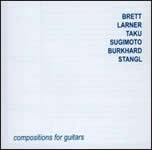|
|
 |
Dusted Reviews
Artist: Brett Larner / Taku Sugimoto / Burkhard Stangl Album: Compositions for Guitars Label: A Bruit Secret Review date: Sep. 8, 2003 |

|
|
|
 |
Six-String Deconstructions
The quiet, minimalist improvisation that has been steadily achieving greater influence and attention in recent years has been far ranging in its instrumental settings (since it is free from conventional associations like, say, the saxophone trio or quartet). But among its most staunch advocates have been guitarists like those featured on this provocative release for the excellent A Bruit Secret label. Taku Sugimoto and Burkhard Stangl are probably more familiar to readers than Brett Larner. Sugimoto has been vastly influential in recent years, contributing dynamite solo recordings (Opposite), performing in occasional group settings (The World Turned Upside Down or Ajar), and forging some excellent duets (such as I Am Happy If You Are Happy with Günter Müller and An Old Fashioned Duet with Stangl). On all these recordings, Sugimoto has wowed listeners with his singular, bell-like playing and clear-tones. Recently, however, he has begun to rethink the possibilities and limitations of the instrument (a process he’s been working out in part through his extremely abstract and near-silent duets with trombonist Radu Malfatti, himself the archduke of minimalist improv). Stangl is something of a mystery, sounding equally convincing in post-Jazz sessions with Franz Koglmann, neo-chamber settings (like his Loose Music or his opera Venusmond), or in the rapt stillness of minimalist eai (check out Recital on Durian or two extraordinary Erstwhile recordings, Schnee and eh). Larner may be best known for his performances on koto (most notably with Anthony Braxton). Recently he’s been exploring the resonating properties of guitars played multiply and simultaneously (he contributed a fantastic track to the Improvised Music from Japan magazine’s gift cd earlier this year).
The disc opens with Larner’s 21-minute “m-7/21-1”, for 21 steel-string acoustic guitars. Some of the other players, in addition to Larner himself, include Bay Area stalwarts Myles Boisen and John Shiurba. Recorded in real time, with no effects or overdubs, this is a chilling, provocative meditation; the flinty, continuous sound is much more akin to sharpened knives than to anything one might customarily associate with guitar. The piece is generally fairly hypnotic but, though there are continuous subtle inflections (almost like different glints from a blade turning in sunlight), there is little change (which doubtless is part of the point). Sugimoto’s piece “Hum” was recorded live at Tokyo’s Grapefruit Moon venue in October 2002, as part of the annual Erstwhile Records festival (documents of which will soon be released on a 7-CD, 1-DVD box set – commence salivating now). Sugimoto is joined by Tetuzi Akiyama, Oren Ambarchi, Toshimaru Nakamura, Yoshihide Otomo, Keith Rowe, and Burkhard Stangl, and they are all credited with playing guitars and amplifiers. It’s a track of extreme stillness and restraint, and the effect is captivating. The tone field is generally established by the hum of the amplifiers, a subtle, at times nearly inaudible sound that crackles and hisses as volume knobs are gently tweaked and as the disruptive presence of feedback is courted (occasionally flaring up loudly).
The final three tracks – “tuning” numbers 1 through 3 (the second subtitled “Folktune”, the third “Dowland”, for the English early music composer) are more obviously radical deconstructions of guitarism by Burkhard Stangl. On each he experiments with detuning during the performance of conventional, even pretty guitar music. The first features an overdub of three steel-string guitars and one Spanish guitar, with Stangl himself detuning the instruments as he plays (there are ghostly overtones hovering everywhere during this one, petering out eventually into the flatulent, clattering sound of slack strings against wood body). “Folktune” begins as a fingerpicked, Fahey-esque tune but soon – courtesy of Taku Sugimoto’s work with the detuner – becomes a twisted, nauseous cartoon of this tradition. Stangl steadfastly continues to play the repeated figure. Dowland’s tradition is similarly disfigured, and this is in some senses the most radical of his pieces. Set alongside some of the incredible recent work of Stangl, this isn’t top drawer. But like this anthology in general, the stuff is powerful and easily recommended.
By Jason Bivins
|







